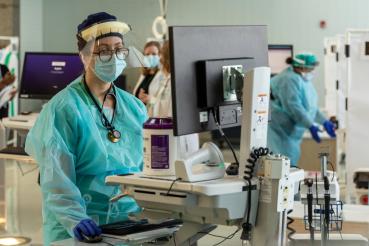While wearing a mask is crucial to limiting the spread of COVID-19, it can take a toll on your skin.
Masking up for extended amounts of time can lead to breakouts, an oily face and even the growth of bacteria on your skin. Masks may also cause chafing, which can lead to severe discomfort. These changes in your skin can also make you feel self-conscious about your appearance.
The good news is there are several ways to prevent and treat acne and irritation caused by frequent face masking usage, also known as “maskne.”
Sonya Kenkare, MD, a dermatologist at Rush River North, offers these six tips to keep your skin healthy and fresh while you do your part to protect yourself and others from COVID-19.
1. Change your mask, clean your mask
One of the best ways to protect your skin from unwanted breakouts is to ensure that the mask you are using is clean. If you are using disposable masks, changing them throughout the day can reduce dirt and oils that may build up on your face.
“Make sure you are changing your masks at least daily if they are disposable,” Kenkare explains. “Oils from your skin can build up on the fabric or paper and can clog pores, resulting in breakouts.”
If your preferred mask is made of fabric, Kenkare suggests cleaning the mask daily. According to the Centers for Disease Control, you can wash your mask by hand or in a washing machine.
Keeping your mask clean will help keep your face clear of blemishes and maintain healthy skin. It will also help you protect against cross-contamination, which can happen when you touch a mask that has been exposed to droplets/aerosols from another person.
2. Treatments and products
When acne arises, you may turn to treatments and skincare products to help clear it up. This is no different when it comes to maskne.
When looking for skin care products to use on the face, Kenkare says to look for products that are oil free or noncomedogenic.
“These are buzzwords that are commonly seen on skin care products, cleansers, sunscreens and make-ups — and they really do make a difference,” Kenkare says. “Oils found in skin care products can actually accumulate on the skin’s surface and result in acne flares.”
When looking for over-the-counter treatments for your maskne, Kenkare says treatments containing salicylic acid and benzoyl peroxide can be helpful for very mild acne. Depending on the product, those active ingredients can be found in spot treatments or washes.
If you’re a first-time user, test the product on a small area of the skin on your inner forearm to make sure your skin can tolerate it before you apply it to your face.
One of the best ways to protect your skin from unwanted breakouts is to ensure that the mask you are using is clean.
3. Rinse your skin regularly
Using a gentle cleanser to wash your face first thing in the morning and right before bed is a great habit for clear, healthy skin.
But if you are wearing a mask all day, Kenkare recommends also keeping a supply of oil-free Cetaphil or CeraVe wipes on hand. Gently wiping your skin clean several times during the day will reduce the amount of sweat and oil that accumulate.
4. Avoid the urge to touch or pick
“Try your best to not touch your face or pick at your maskne,” Kenkare says.
This may be one of the harder tips to put into practice; touching your face or picking at acne is an easy habit to get into. But touching your face transfers oils from your hands to your face, which can block pores and create acne; and picking at your acne can make the appearance of the acne worse in the long-term. So while it may be tough to avoid the urge to touch and pick, a hands-off approach is best for your skin.
5. Reduce the friction
If you’re experiencing discomfort or chafing from your mask, try to adopt techniques that reduce friction between the mask and your skin.
Loosening the mask straps, using pads under the straps behind the ears or using a headband style mask can help. You can also consider using a larger mask or a mask of a different style.
6. Make an appointment
If you’re using oil-free products and cleaning your mask and face regularly but are still experiencing discomfort or acne, the mask may not be the culprit.
Kenkare suggests making an appointment with a board-certified dermatologist to determine what’s causing your symptoms, or to get a recommendation on which treatments and skin care products will work best for your skin (since everyone’s skin is unique).
“We are always happy to help treat acne and help our patients achieve their aesthetic goals,” Kenkare says.
While wearing a mask is our new normal, maskne doesn’t have to be. A few extras steps in your skincare and mask care routines or a trip to the dermatologist can help you put your best face forward.




